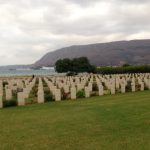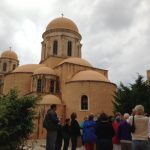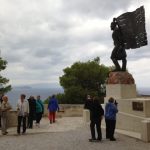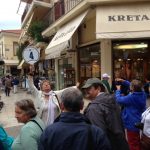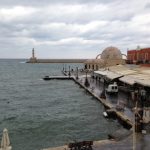Yesterday we arrived in Crete. It’s been one of those places that has always interested me due to reading one of my Father’s books about some British operatives in WW2 that abducted the German commander and herded him around the island with the Germans hot on their tail, to then escape to Egypt. See Ill met by moonlight – http://en.wikipedia.org/wiki/Ill_Met_by_Moonlight
The second exposure was during high school where we touched on Minoan culture BC and a little bit of Greek mythology and history, and later in life, the Australia Imperial Force in World War 2 on the island of Crete in 1941.
We arrived early in the morning at the port of Souda, the main port for Charnia, pronounced harnia.
We left at 7.45am and were headed for the Commonwealth War Graves, a visit to the Monastery of Agia Triada Tsangarolon (Holy Trinity Monastery) and a walk through the heart of Charnia and shopping time.
The Commonwealth War Graves
For Australian service people who have served and died for our country in the last two world wars and have been buried overseas, the Commonwealth War Graves Commission provides the maintenance and management service for official war graves.
The cemetery we visited at Crete bears testament to those who had fallen in the line of duty defending against the German invasion in 1941. There were more Kiwis buried there than Australians, testament to the New Zealand units who remained there for some time. For more about the battle itself, go to http://www.awm.gov.au/atwar/crete.asp.
We had two New Zealanders on our visit who were very emotional at the cemetery, they had a strong connection to their fellow countrymen who lost their lives there on the very spot where we were standing.
Monastery of Agia Triada Tsangarolon (Holy Trinity Monastery)
This was a gem in this tour, a monastery. The Monastery of Agia Triada Tsangarolon is a Greek Orthodox monastery. It also contains a museum.
The name means “Holy Trinity”, was built in the 17th century by two brothers of the Venetian Zangaroli family on the site of a pre-existing church.
It was a fascinating visit and one that was made more interesting by our guide Katerina.
On our whole tour of Charnia, Catarina sang, read poetry, shared her philosophy of life and of course provided us with a valuable history of Crete, she loves life. There’s a picture of Katerina holding our tour guide sign.
Next we headed to the memorial that overlooks the town of Charnia. Here the national hero stands with the Cretian flag in memorial of their struggle in the past against Turkey. The horizontal strips on the Greek flag come from this struggle and signify the joining of Crete to Greece.
Downtown Charnia
This is great little spot. When we arrived, the traffic was hotting up and getting busy. Downtown traffic doesn’t work like we know it in Australia, in fact resembles more like traffic in Phnom Penh, Cambodia, hectic but works.
After a walk down the main shopping street, we ended up next to the harbour. A really pretty spot with shops on forefront and harbour protected by an old fort. As the day was cool and the weather unstable, the water from the harbour lapped over the edge of the walkway to the front of some of the coffee shops on the foreshore where customers dine outside, interesting.
Next stop was some coffee then shopping at Leather Street.
Crete is one of those places I would like to come back and explore further.
We returned to the ship by 1.00pm ready for our departure at 2.45pm.
Today is a full day’s sailing to Venice.
Chris and Annette
